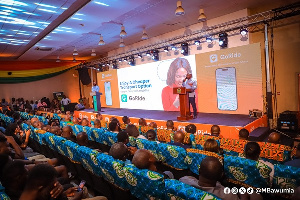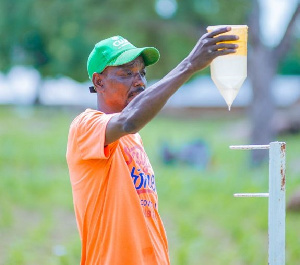Regional News of Thursday, 6 October 2022
Source: WaterAid
Anafobissi community fights climate change with deeds
The members of the Anafobissi community in the Upper East Region of Ghana have been systematically combatting climate change impacts in spite of having no words for it in their own Gruni language.
The north of the country, which has seen temperatures rise by 1 degree over the past 25 years and has also seen increasingly erratic rains and dry spells, is battling the impacts of climate change. The population is increasingly forced to make do with the available water – which is becoming ever more scarce.
With the support of WaterAid, they have established a simple but highly effective system to monitor both rainfall and groundwater levels over the last seven years. In only two of those has there been sufficient water for their needs.
WaterAid Ghana’s Programme Officer, Felix Gbevillah explains that their valuable data shows how unpredictable the weather has become in the area with almost the entire annual rainfall now falling in an intense seven-week period each year, with little capacity to harvest and store for future irrigation needs.
Their readings clearly demonstrate the uncertainty and variability with which they are living.
• In 2017 their total annual rainfall fell below one metre and the maximum they monitored was 1.23m in 2020; This compares with a national average for Ghana of 1.2m pa
• In the two main rainy season months of July and August, the rainfall in August 2019 was almost twice that of July 2017 further demonstrating the pattern of unpredictability;
• During their dry season, which lasts from November to March inclusive, barely a drop of rain fell at all over the whole five-year period.
When the monitors report that supplies are beginning to run dry, the District Assembly imposes a rationing system which prioritises basic human needs to drink, cook, and keep clean over construction work and then, ultimately, over watering livestock.
“In this way, we are able to use the water until the rain comes.” says groundwater monitor and health volunteer Aduko Mercy Atarewula.
“When this assessment is done, the community themselves will take measures to ensure that they at least have water to meet their basic needs as well as their small livelihood activities that help them to sustain their lives and to be able to manage the effects of climate change better,” says WaterAid Ghana’s Programme Officer, Felix Gbevillah.
“Sometimes [the rain] comes late and sometimes it doesn’t come safely,” says rainfall monitor and teacher Atidaa Otto. “At the time when [the farmers] don’t want it, that will be the time that it also comes and it will spoil their crops that year.”
There has been an unsuccessful attempt to build a sand dam on the seasonal stream to harvest the water when the rains come but only a green slimy puddle remains.
Anafobissi is a subsistence farming community of just over three thousand people in the Bongo District of the Upper East region of Ghana, bordering Burkina Faso. It’s one of the country’s poorest regions, not helped by its rocky landscape.
In 2016 WaterAid Ghana, through Bongo District Assembly, partnered with disaster-prone Anafobissi community to support water resources monitoring. They supported the community in understanding the need to safeguard their precious water resources, but there remains limited understanding of climate change and its causes.
“The rainfall pattern has changed. It doesn’t rain like it used to before,” says farmer Aniah Asaana. “We are not able to determine why it doesn’t rain that way. The rains come from above and we are not up there to know why it doesn’t fall that way.”
To add to the challenges, many boreholes in the region have had to be capped due to high levels of naturally-occurring fluoride which seeps into the groundwater from the rocks.
Opinions










